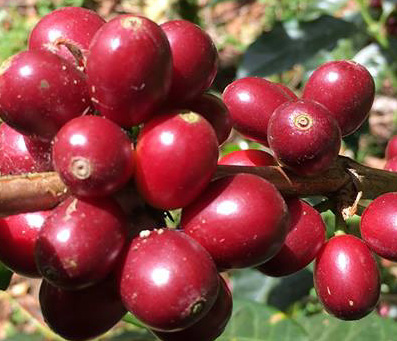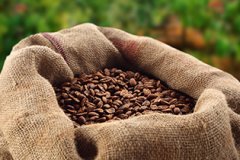With the climate warming, coffee is facing the double threat of the loss of arable land and the reduction of bees.

For professional baristas, please follow the coffee workshop (Wechat official account cafe_style)
The total amount of land suitable for coffee farming is expected to fall by 73% to 88% by 2050, the lead author told carbon brief. Most importantly, the number of honeybees-- pollinated coffee plants-- can be as high as 18%, by the way, due to climate change.
The study is the first to investigate the ways in which two direct and indirect consequences of climate change can overlap to threaten coffee production, another scientist told carbon brief. Using this approach to research in the future could help us better understand how climate change threatens other key crops, he said.
The trouble of brewing
Latin America is the largest coffee producing region, accounting for 80% of global Arabica coffee production in the world. Arabica coffee is the most popular coffee in the world, accounting for 70% of global production. The second most popular bean, Robles, is mainly produced in sub-Saharan Africa.
Coffee farmer picking coffee organic beans in Uganda, Africa. Image shot 01/2007.
Coffee farmers pick organic coffee beans in Uganda, Africa, January 2007. Credit: Simone Reese / Alami stock photo.
More than 80% of coffee in Latin American countries is grown by small farmers on less than four hectares of land. Studies have shown that small farmers are particularly vulnerable to the loss of good farming conditions due to climate change.
Climate change poses a double threat to coffee production in the region, explaining Chi Pablo Imbach, the new lead author of the study is published in the Proceedings of the National Academy of Sciences. He told carbon briefly:
"We are looking for coupling changes in bee diversity, coffee plants responsible for pollination, and coffee productivity in areas suitable for coffee in the context of climate change. we have found a suitable place to greatly reduce coffee in the future.
Climate change is expected to reduce the amount of land used for coffee cultivation to bring higher temperatures, increase the risk of drought and make rainfall more unpredictable, according to the Intergovernmental Panel on Climate change (IPCC IPCC).
Glossary of terms
RCP4.5: (represents concentration pathway) garbage collection stations are scenarios of future concentrations of greenhouse gases and other forces. RCP4.5 is a "stabilization scheme" in which policies are placed at the level of CO2 in the atmosphere. Read more
Model simulation in the study shows that in the case of intermediate emissions (RCP4.5), the coffee production of land suitable for Latin American countries is expected to decline by 73%, by 2050, the total amount is compared to 1950-2010.
And in a high-emission scenario (RCP8.5) to reduce global greenhouse gas emissions, land suitable for coffee farming could fall by 88% by 2050, the study said.
Low-lying countries with no significant mountains, including Nicaragua, Honduras and Venezuela, are expected to apply to the largest losses in farmland. This is because some low-lying areas are expected to become too warm to grow coffee under climate change.
Glossary of terms
RCP8.5: (represents concentration pathway) garbage collection stations are scenarios of future concentrations of greenhouse gases and other forces. RCP8.5 is a scenario of "relatively high greenhouse gas emissions" that leads to rapid population growth. Read more
However, some countries actually have access to farmland suitable for coffee production under climate change, studies have shown. The results show that about 12% to 30% of the future suitable land for coffee farmers will occur in the area currently not suitable for coffee production.
Countries may benefit from Mexico, Guatemala, Colombia and Costa Rica. All of these countries have mountainous areas that are expected to become mild and therefore more suitable for coffee production in the context of climate change.
Bitter bees
In the case of farmland losses, climate change can also be found to harm coffee production by reducing the number of bees. Climate change can threaten bees in different ways, including by tarnishing the quality of the pollen they depend on.
Tetragonisca angustula, a small eusocial stingless bee found in Central and South America, is heading for its hive. Coello, Tolima, Colombia.
Tetragonisca angustula, in Central and South America, found small social stingless bees titled its hives, America, Tolima, Colombia, 2017-12-2. Credit: Jorge Garcia / VWPics / Alami stock photo.
Dozens of honeybee species, including native stingless bees, play a key role in crop productivity pollinated by coffee plants, Imbach said:
"bees are crucial to the integrity of the coffee plot. Without them to provide services through pollination, coffee production will decline-which will directly affect the income of farmers.
The map below shows how the number of honeybee species is expected to change in Central and South America in the case of RCP4.5 by 2050. Dark blue indicates the gain of the bee species, while red shows the loss in the field.
A map showing expected change in the number of bee species in Central and South America by 2050 under a moderate warming scenario (RCP4.5). Dark blue indicates a gain in the number of bee species, while deep red shows areas of loss. Source: Imbach et al. 2017
The map shows expected changes in the number of honeybee species in Central and South America to 2050 in the case of mild climate warming (RCP4.5). Dark blue indicates the gain of the bee species, number, while crimson shows the loss in the field. Source: Imbach et al. 2017.
The map shows that the loss of honeybee species richness may reach low-lying, tropical Latin American countries. In these areas, bees may not be able to move higher, and temperatures are expected to be cooler in the future, Imbach explains:
These larger [bee diversity] reduce the increased temperature compensation that occurs in lowland areas where local species cannot climb and move, thus losing areas with a suitable climate.
In the case of RCP4.5, the average number of honeybee species expected to decline to 8 per cent in future coffee-friendly areas is lower than the 2050 figure between 1950 and 2010. Under RCP8.5, the species richness of honeybees is expected to decline by 18%.
However, the analysis shows that despite the losses, coffee farms will retain at least some of their native bees in the future, Imbach said:
"We found that although there will be fewer bee species where coffee is suitable in the future, it will still be possible for all future coffee fields to have honeybee species diversity to support pollination services.
Double shooting
The study is the first to investigate how climate change can threaten future coffee production both directly (through appropriate farmland losses) and indirectly (through falling pollination), said Dr Aerts, a researcher from Leuven University who was not involved in the new study. He told carbon briefly:
Recently, a large number of studies on the suitability of coffee sites under climate change scenarios have been published in top journals, but these studies only use climate models and assessment websites for coffee based on expected changes in temperature and rainfall. This is an important study in a wide range of areas of biodiversity, ecosystem services and climate change.
This approach allows researchers to simulate the overlap of the dual effects of farmland and pollinator losses in different parts of the continent.
They found continents in Honduras and southern Mexico, including part of the expected loss of experience in farmland and bee species richness. This could make coffee production impossible for many small farmers, Imbach said.
In other regions, however, the situation is much more complicated. In western Colombia, for example, the amount of arable land is expected to increase, while honeybee diversity is expected to decline.
In these areas, careful farming methods can help small farmers maintain their livelihoods, Imbach said.
"this work should help the coffee sector improve management practices on farms so that honeybee populations can thrive. But there is also a need to protect honeybee habitats that point to non-farmers-typical tropical forests-so that bees can continue to provide these vital services to millions of smallholder coffee producers.
Research shows that future strategies to address climate change on coffee production need to consider more than the expected changes in rainfall and temperature effects, Aerts said.
"the next step will be changes in coffee pests and diseases, including climate change scenarios, as these are expected to shift under climate change."
Important Notice :
前街咖啡 FrontStreet Coffee has moved to new addredd:
FrontStreet Coffee Address: 315,Donghua East Road,GuangZhou
Tel:020 38364473
- Prev

Don't just drink transparent milk tea! Japan is crazy about "Coca-Cola Coffee", which is only sold by machines.
For the exchange of professional baristas, please pay attention to the coffee workshop (Wechat official account cafe_style). There is a whirlwind of transparent milk tea in Taiwan, but recently, Coca-Cola in Japan has a new idea, introducing super-crazy Coca-Cola coffee, so that people can drink coffee and carbonated drinks at the same time, but it is not so easy to drink, because this Coca-Cola coffee is only sold in vending machines.
- Next

With Belt and Road Initiative's advantage and coffee channel, Chongqing in Europe has become the biggest coffee in China.
Professional baristas please pay attention to the coffee workshop (Wechat official account cafe_style) does not produce coffee beans, but can create the largest spot coffee trading platform in China. Chongqing Coffee Trading Center has exceeded 10 billion yuan since June 2016, making it the largest spot coffee trading platform in China, Chongqing Daily reported today (2). Report
Related
- Why can American refills for free? The difference between Americano and American drip pot coffee
- Being chased out of the rain in front of Starbucks?! Store: Sheltering from rain under umbrellas poses a safety hazard
- The white moonlight has changed?! Lucky launches "Big Winter Pear American"
- Hand-brewed coffee three-stage method, high-sweet and universal brewing method to share! What does the high sweet water level of hand-brewed coffee mean?
- What is the difference between raw, refined and full espresso coffee? How to extract espresso and taste good?
- A complete list of coffee bean names and their meanings! What is Yejia Shefi coffee? Where is Mantelin coffee?
- What grade does Arida Manor Kaduai coffee beans belong to? What treatment is Arida ASD slow anaerobic sun exposure?
- The milk tea cup becomes smaller?! Overlord Tea Girl launches a new "Return to Yunnan" series
- Accused of selling counterfeit and high-priced coffee beans! Well-known boutique coffee brand "Oukelao" bowed and apologized!
- How to make espresso dumplings? Can I eat coffee and glutinous rice balls together?

